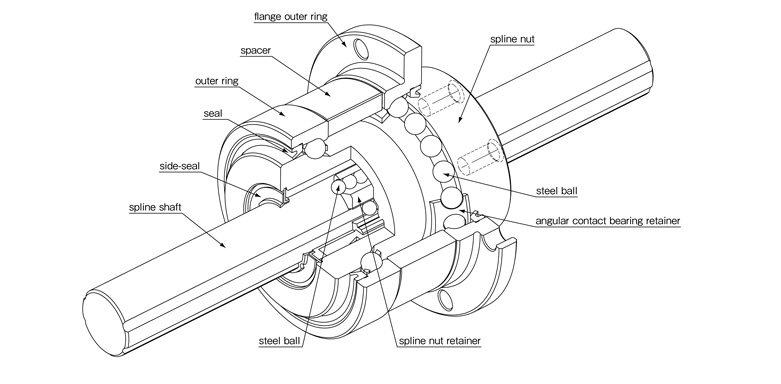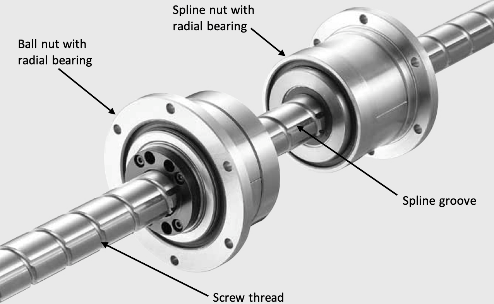Ball screw splines are a combination of two components - a ball screw and a rotating ball spline. By combining a drive element (ball screw) and a guide element (rotary ball spline), ball screw splines can provide linear and rotary movements as well as helical movements in a highly rigid, compact design.
---Ball Screw
Ball screws use circulating steel balls in a precision-machined nut to drive loads to precise positions. In most designs, the screw is secured at one or both ends and the nut is prevented from rotating by a keyed housing or other anti-rotation device. Because the screw is restricted from moving linearly, the motion is transferred to the ball nut, which moves along the length of the screw shaft.
Another ball screw design incorporates radial angular contact bearings on the outer diameter of the nut, allowing the nut to be driven—usually via a belt and pulley assembly connected to the motor—while the screw remains completely stationary. When the motor turns, it rotates the nut across the length of the lead screw. This setup is often called a "driven nut" design.
---Ball Spline
Ball splines are a linear guidance system similar to round shaft and recirculating ball bearings, but with precisely machined spline grooves along the length of the shaft. These grooves prevent the bearing (known as a spline nut) from rotating while still allowing the ball spline to transmit torque.
A variation of the standard ball spline is the rotary ball spline, which adds a rotating element - a gear, crossed roller or angular contact ball bearing - to the outer diameter of the spline nut. This allows the rotary ball spline to provide both linear and rotary motion.

---How Ball Screw Splines Work
When a driven nut type ball screw assembly is combined with a rotating ball spline, the resulting configuration is commonly referred to as a ball screw spline. The shaft of a ball screw spline has threads and spline grooves along its length, with the threads and grooves "crossing" each other.

A ball screw spline has a ball nut and a spline nut, each with a radial bearing on the outside diameter of the nut.
Three types of motion: linear, helical and rotary.

Ball screw spline assemblies limit the linear movement of ball screw nuts and ball spline nuts. By driving the ball nut and spline nut together or individually, three different types of motion can be produced: linear, helical and rotary.
For linear motion, the ball nut is driven while the spline nut remains stationary. Since the ball nut cannot move linearly, the shaft passes through the ball nut. The stationary spline nut prevents the shaft from rotating at this point, so the movement of the shaft is purely linear with no rotation.
Alternatively, when the spline nut is actuated and the ball nut remains stationary, the ball spline induces a rotary motion and the threads through which the ball nut is secured cause the shaft to move linearly as it rotates, resulting in a helical motion.
When both nuts are actuated, the rotation of the ball nut essentially cancels out the linear motion induced by the ball spline, so the shaft rotates without any linear travel.
Post time: Mar-11-2024






